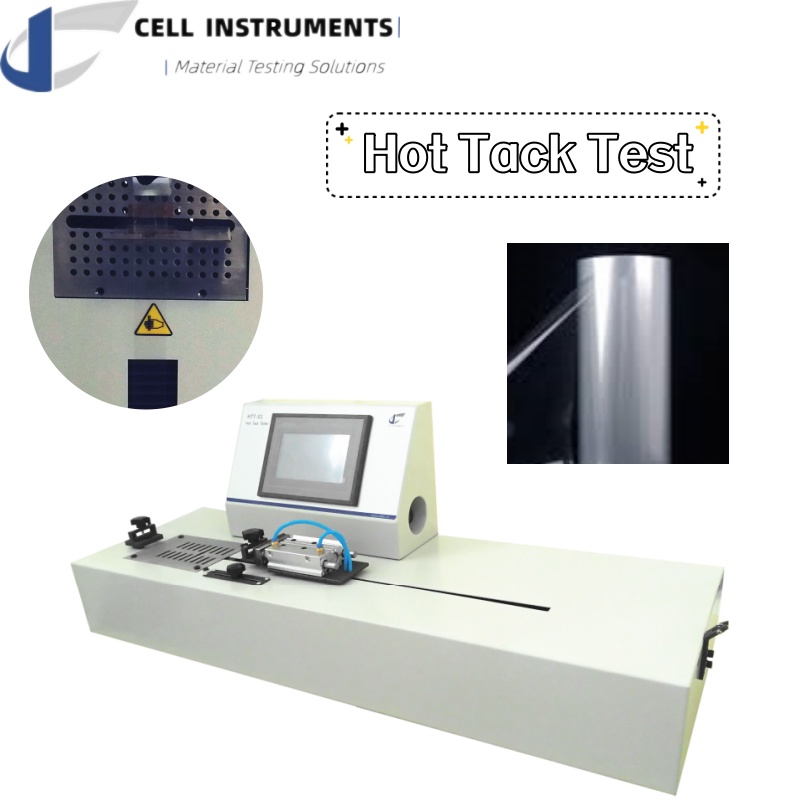In the dynamic field of food packaging, ensuring the integrity and strength of seals is crucial to maintaining product quality and safety. One of the pivotal tests in this realm is the hot tack test, a method used to evaluate the strength of a heat seal while it is still hot. This test is essential for determining the ideal sealing conditions for packaging materials, especially those used in food packaging. This article delves into the importance of hot tack testing, the standards guiding these tests, and how Cell Instruments' Hot Tack Tester stands out in this critical industry.
Hot tack testing measures the strength of a heat seal while it is still in a molten state, just after sealing but before it cools down and solidifies. This is crucial for food packaging applications where seals are often subjected to stress immediately after formation. A reliable hot tack tester ensures that the packaging can withstand these stresses, preventing leaks and maintaining product freshness.
The food packaging industry demands high-performance materials that ensure product safety, longevity, and customer satisfaction. Hot tack tests are vital for:
1. Maintaining Seal Integrity: Ensuring that seals can withstand handling and processing immediately after sealing.
2. Optimizing Sealing Conditions: Determining the ideal temperature, pressure, and dwell time for creating robust seals.
3. Ensuring Product Safety: Preventing contamination and spoilage by ensuring airtight seals.
4. Enhancing Consumer Confidence: Delivering products that remain fresh and uncontaminated until they reach the consumer.
Two key ASTM standards provide guidelines for hot tack testing: ASTM F1921 and ASTM F2029.
ASTM F1921: This standard outlines the test methods for determining the hot tack and heat seal performance of flexible webs. It provides a systematic approach to evaluate the quality of heat seals and their performance under different conditions.
ASTM F2029: This standard specifies the standard test method for making heat seals and evaluating the heat sealability of flexible barrier materials. It focuses on the procedures to create heat seals and the criteria for their assessment.

Cell Instruments' Hot Tack Tester is designed to meet the rigorous demands of the food packaging industry. Our tester offers precise control over sealing parameters, ensuring accurate and repeatable results. Key features include:
1. Advanced Control Systems: Allowing fine-tuning of temperature, pressure, and sealing time.
2. User-Friendly Interface: Simplifies test setup and data analysis.
3. Compliance with ASTM Standards: Ensuring tests meet industry standards for reliability and accuracy.
4. Customization Options: Catering to specific testing needs and automation requirements.
1. Prepare the Sample: Cut the packaging material to the required dimensions.
2. Set Up the Tester: Adjust the temperature, pressure, and dwell time based on the material specifications.
3. Create the Seal: Use the hot tack tester to create a heat seal on the sample.
4. Measure the Strength: Immediately measure the strength of the seal using the tester.
5. Analyze the Data: Compare the results to the desired performance criteria.
Using our hot tack tester offers several benefits:
1. Enhanced Product Quality: Ensures strong, reliable seals that protect product integrity.
2. Operational Efficiency: Optimizes sealing parameters to reduce waste and improve productivity.
3. Cost Savings: Reduces the likelihood of packaging failures and associated costs.
Previous: How Does a Hydraulic Scissor Platform Lift Enhance Workplace Efficiency?
Next: What features make scooter motors appealing to students?
Copyright:@2020-2021
Comments Please sign in or sign up to post.
0
0 of 500 characters used